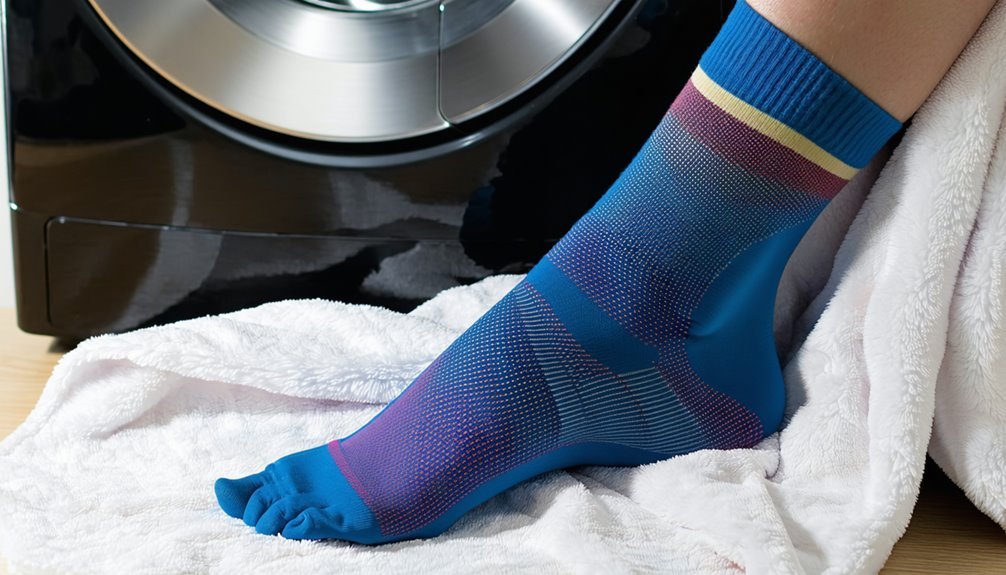Can You Wash Compression Socks?
You can definitely wash compression socks, and it's vital to do so to maintain their efficacy and hygiene. Washing them after each use removes sweat and bacteria, preserving the socks' structural integrity. To prevent damage, use gentle liquid detergents and opt for air drying on a flat surface. Avoid high water temperatures and harsh soaps, as these can degrade elasticity. Following these practices guarantees your socks provide continual benefits. Explore further to deepen your understanding.
Understanding Compression Socks and Their Purpose

Compression socks, a specialized type of hosiery, are designed to apply graduated pressure to your legs, thereby enhancing blood circulation and reducing discomfort. These socks are particularly beneficial for individuals who spend long hours standing or sitting, as they help prevent venous disorders such as deep vein thrombosis. By promoting effective venous return, compression sock benefits include reduced swelling and fatigue. When considering compression sock usage, it's vital to select the appropriate level of pressure, typically measured in millimeters of mercury (mmHg), to guarantee efficacy and safety. For ideal results, make sure socks fit snugly without constricting. Proper usage not only aids in maintaining vascular health but also contributes to overall leg comfort. This evidence-based approach underscores their role in preventive health measures.
The Importance of Proper Care for Compression Socks
Although they play a crucial role in maintaining vascular health, taking proper care of your compression socks is essential to guarantee their longevity and effectiveness. Proper care maximizes compression sock benefits, ensuring they retain their elasticity and provide adequate pressure. Safeguarding their integrity involves meticulous cleaning and proper sock storage. Always hand wash or use a gentle cycle with cold water, avoiding harsh detergents. Dry them flat to maintain their structure.
| Care Aspect | Recommended Practice | Safety Benefit |
|---|---|---|
| Washing | Hand wash or gentle cycle | Maintains elasticity |
| Water Temperature | Cold | Prevents fabric damage |
| Detergent | Mild | Reduces skin irritation |
| Drying Method | Flat dry | Preserves compression levels |
| Storage | Cool, dry place | Prevents degradation |
Common Materials Used in Compression Socks
Understanding the materials used in compression socks is key to making informed decisions about their care and effectiveness. Nylon blends are prevalent due to their durability and elasticity, providing consistent pressure and shape retention. The integration of spandex fibers enhances flexibility, ensuring a snug fit without compromising your comfort or safety. Cotton variations, though less common, offer breathability and softness, catering to those with sensitive skin. It's crucial to take into account moisture-wicking properties, particularly if you're wearing these socks for extended periods. Effective moisture management reduces the risk of bacterial growth and skin irritation, ensuring a hygienic experience. Each material has specific care requirements that influence the sock's lifespan and performance, demanding your attention to maintain their peak function and safety.
When to Wash Your Compression Socks

To maintain the best performance and hygiene of your compression socks, it is essential to establish a routine for washing them. Evidence suggests that washing frequency should ideally be after each use. This practice guarantees effective odor removal and maintains the socks' compression efficacy. Daily washing prevents the accumulation of sweat, bacteria, and potential allergens, which could compromise your skin's safety and the socks' fabric integrity. Over time, neglecting regular washing can lead to persistent odors and deterioration of the material's elasticity. Utilizing technical fabrics, these socks rely on maintaining their structural integrity to deliver consistent compression levels. For best results, adhere to this washing frequency to make certain your compression socks remain safe, functional, and hygienic for daily use.
Preparing Compression Socks for Washing
Before washing your compression socks, it's essential to first examine the care instructions provided by the manufacturer, as improper handling can compromise their elasticity and effectiveness. Next, make certain you separate socks by color to prevent any dye transfer, a practice supported by textile care studies. Finally, remove any accessories like zippers or grips, which can cause damage during the washing process, guaranteeing a longer lifespan for your socks.
Check Care Instructions
When preparing to wash your compression socks, it's crucial to first examine the care instructions provided by the manufacturer, as these guidelines are specifically designed to preserve the integrity and efficacy of the fabric. The care label often details critical information such as the appropriate washing frequency and temperature settings. Adhering to these instructions prevents damage and guarantees your socks continue to provide therapeutic benefits.
| Care Label Element | Importance |
|---|---|
| Washing Frequency | Prevents material degradation |
| Temperature Settings | Maintains elasticity |
| Detergent Type | Reduces chemical wear |
| Drying Method | Preserves structural integrity |
Separate Colors Properly
How should you approach the task of sorting your compression socks before washing them? Properly separating colors is essential to prevent color bleeding and fabric fading, ensuring your socks remain vibrant and effective. Begin by categorizing your socks based on color intensity. This reduces the risk of darker dyes transferring to lighter fabrics.
Here's a checklist to help you sort effectively:
- Bright colors: Group socks with vivid hues to prevent dulling.
- Dark colors: Keep dark socks together to avoid bleeding into lighter pairs.
- Light colors: Wash separately to maintain their brightness.
- New socks: Wash alone initially, as they're prone to bleeding.
- Mixed fabrics: Separate materials to reduce wear and maintain elasticity.
Remove Any Accessories
After you've sorted your compression socks by color and material, the next step is to remove any accessories that could interfere with the washing process. Sock accessories, such as clips or straps, may cause damage to your socks or the washing machine. Accessory removal is essential for maintaining the integrity and longevity of your compression socks.
| Step | Action Taken |
|---|---|
| Step 1 | Identify any attached sock accessories |
| Step 2 | Carefully detach clips or fasteners |
| Step 3 | Inspect for any remaining loose elements |
| Step 4 | Store accessories separately for safety |
Machine Washing vs. Hand Washing: Which Is Best?
When considering the ideal method for laundering compression socks, machine washing offers the benefit of convenience and time efficiency, supported by studies that suggest minimal impact on fabric integrity when using a gentle cycle and cold water. However, hand washing is often recommended for maintaining the elasticity and compression level of the socks, as it allows for precise control over water temperature and detergent concentration, which can prevent premature wear. Ultimately, the decision should be informed by the manufacturer's care instructions and your personal priorities regarding convenience and longevity.
Machine Washing Benefits
For those seeking efficiency and convenience, machine washing offers significant advantages over hand washing when it comes to cleaning compression socks. Machine washing can effectively maintain ideal cleaning frequency, guaranteeing that your socks are hygienically fresh without the manual labor involved in hand washing. The process also supports fabric care by utilizing controlled water temperature and gentle cycles, reducing the risk of damage. This method guarantees that the compression properties remain intact while minimizing wear and tear.
- Consistent Cleaning: Automated cycles provide uniform cleanliness.
- Fabric Protection: Controlled settings protect delicate fibers.
- Time-Saving: Reduces the time commitment compared to hand washing.
- Safety Assurance: Proper washing reduces bacterial growth and odor.
- Convenience: Allows simultaneous washing of multiple pairs, enhancing efficiency.
Hand Washing Advantages
While machine washing offers notable conveniences, hand washing compression socks provides distinct advantages for those who prioritize fabric longevity and personalized care. By employing precise hand washing techniques, you can minimize fiber degradation, leading to prolonged sock durability. Gently massaging the fabric in lukewarm water with mild detergent guarantees that the elastic integrity remains intact, preserving the compression level critical for therapeutic benefits.
A benefits overview reveals that hand washing reduces the risk of mechanical damage, such as stretching or snagging, commonly associated with machine cycles. Additionally, it allows for thorough inspection, guaranteeing the socks maintain their structural efficacy. For those concerned with safety, hand washing diminishes exposure to harsh chemicals found in some detergents, offering a gentler approach to maintaining your compression socks.
Recommended Detergents and Cleaning Agents
Understanding the appropriate detergents and cleaning agents for washing compression socks is essential to maintaining their elasticity and effectiveness. Utilizing gentle detergents guarantees the fibers remain intact, prolonging the lifespan of these specialized garments. Opt for eco-friendly options, as they minimize exposure to harmful chemicals, promoting both safety and sustainability. Here are some recommended choices:
- Gentle liquid detergents: Ideal for maintaining fabric integrity.
- Eco-friendly detergents: Reduce chemical exposure and environmental impact.
- Detergents free from bleach: Prevents fabric degradation.
- Hypoallergenic formulas: Safe for sensitive skin.
- Mild soap flakes: Effective for delicate wash cycles.
These selections guarantee the structural integrity of your compression socks, providing peace of mind and safe washing practices. Prioritizing these options supports both your health and the environment.
Drying Techniques for Compression Socks

Proper drying techniques are essential to preserving the elasticity and compression properties of your socks. To guarantee longevity, consider air drying as one of the most effective drying methods. Unlike machine drying, air drying maintains the structural integrity of the compression fibers, preventing heat-induced degradation. Lay your socks flat on a clean towel in a well-ventilated area, avoiding direct sunlight to minimize UV damage. This method allows moisture to evaporate evenly, reducing the risk of fiber distortion and guaranteeing consistent pressure application. For peak results, turn your socks inside out to facilitate thorough drying. These careful drying methods not only extend the lifespan of your compression socks but also maintain their therapeutic benefits, ensuring your safety and comfort.
Mistakes to Avoid When Washing Compression Socks
When washing compression socks, it's essential to avoid incorrect water temperature, as high temperatures can degrade the elastic fibers, reducing their therapeutic efficacy. Utilizing harsh detergents with strong chemicals can further compromise the sock integrity by breaking down the fabric and causing skin irritation. Instead, opt for mild, hypoallergenic detergents and wash in lukewarm water to maintain both the functional and structural integrity of the socks.
Incorrect Water Temperature
While washing compression socks, paying attention to water temperature is essential to maintaining their elasticity and compression efficacy. Incorrect water temperature effects can lead to degradation of materials and loss of therapeutic benefits. Research indicates that ideal washing temperatures for compression socks are typically between 30°C to 40°C. Higher temperatures can cause the fibers to expand and weaken, reducing compression levels, while lower temperatures might not effectively remove oils and bacteria.
To guarantee safety and longevity:
- Use lukewarm water for washing.
- Avoid hot water to prevent fiber damage.
- Check the care label for specific temperature guidelines.
- Rinse thoroughly to remove all detergent residues.
- Air dry instead of using high-heat dryers.
Using Harsh Detergents
Although it might seem convenient to use any available detergent, selecting the right type is crucial to preserving the integrity of compression socks. Harsh detergents' effects can compromise the fabric's elasticity, leading to decreased compression socks durability. Such detergents often contain strong chemicals like phosphates, enzymes, or bleach, which can break down the delicate fibers. This degradation affects the socks' ability to maintain consistent pressure, which is necessary for their therapeutic function. To guarantee safety and longevity, opt for mild, hypoallergenic detergents free of these aggressive additives. Additionally, avoid fabric softeners, as they can further weaken the material. By choosing the right cleaning agents, you'll help maintain your compression socks' effectiveness and protect your investment in your health.
Tips for Maintaining the Longevity of Your Compression Socks
To guarantee your compression socks endure over time, it's crucial to adhere to specific maintenance techniques backed by evidence-based practices. Proper care not only preserves the compression sock benefits but also guarantees the effectiveness of chosen compression levels. Here are key practices:
- Gentle Washing: Use cool water and mild detergent to prevent fiber breakdown.
- Avoid Heat: Air-dry your socks; heat can compromise elastic fibers.
- Rotate Pairs: Alternating pairs reduces wear and extends lifespan.
- Proper Storage: Store flat or rolled, not folded, to maintain elasticity.
- Inspect Regularly: Check for damage or reduced elasticity, replacing as needed.
Frequently Asked Questions
Can You Iron Compression Socks After Washing?
Ironing compression socks? That's a no-go. Compression sock care prioritizes maintaining elasticity, and ironing techniques can damage the fibers. Scientific consensus advises against it. Instead, air-dry them to guarantee safety and longevity, preserving their therapeutic benefits.
How Do Compression Socks Affect Circulation?
Compression socks improve blood flow by applying graduated pressure, enhancing venous health. They help reduce venous pooling, promoting efficient circulation. You'll find they're essential for preventing clots, managing edema, and ensuring your overall circulatory system's safety.
Are Compression Socks Suitable for All-Day Wear?
Like Achilles' armor, compression socks can support you all day, but it depends on comfort levels and material types. Make certain you select high-quality fabrics to maintain peak safety, encouraging healthy circulation without compromising comfort or skin integrity.
Can You Wear Compression Socks While Sleeping?
Wearing compression socks while sleeping isn't typically recommended unless advised by a healthcare professional. While they offer nighttime comfort, potential sleeping benefits are outweighed by risks like impaired circulation or pressure sores. Prioritize safety and consult your doctor.
How Do Compression Socks Help With Travel-Related Swelling?
Studies show 75% of travelers experience leg swelling. Compression socks offer travel benefits by applying consistent pressure, promoting blood flow, and reducing swelling. They're essential for safety, preventing discomfort and potential complications like deep vein thrombosis during long flights.







